A Cultural Melting Pot Leading to Surprising Creative Harmony. The Two Chefs of Gucci Osteria by Massimo Bottura in Florence Mark Further Culinary Progress.
The story
"Art is existence - Christo Vladimirov Javacheff once said in an interview - not a profession, but an intensely personal matter." The artist, known for his wrapped art duo with Jeanne-Claude Denat de Guillebon in the 1960s, likely drew this belief from a life spent creating as a pair. This activity, while ongoing, melds two individuals into one, just as the act of creation becomes one with living. Working together as a singular creative force, two people have accurately captured the essence of Gilbert & George, another significant artistic partnership.

When a life project takes on the form of joint creativity, personal relationships merge with artistic ones. Passion and love become the driving forces of the creative process, emotions that inspire innovation and ingenuity. This can be sensed at Gucci Osteria by Massimo Bottura in Florence since Takahiko "Taka" Kondo joined his wife Karime Lopez as Co-Executive Chef.

Almost a decade has passed since they met at a culinary event in Italy, a moment that sparked love. He had arrived from Tokyo nine years earlier and become Massimo Bottura's right-hand at Osteria Francescana. She, from Mexico City, worked as a sous chef at Virgilio Martinez's Central in Lima. After years of back-and-forth trips between Modena and Lima for even just a weekend together, it was the Mexican chef who decided to move to Italy. They got married. In 2018, Karime officially took the reins of Gucci Osteria in Piazza della Signoria, and the following year, she became the first Mexican woman in history to earn a Michelin star.
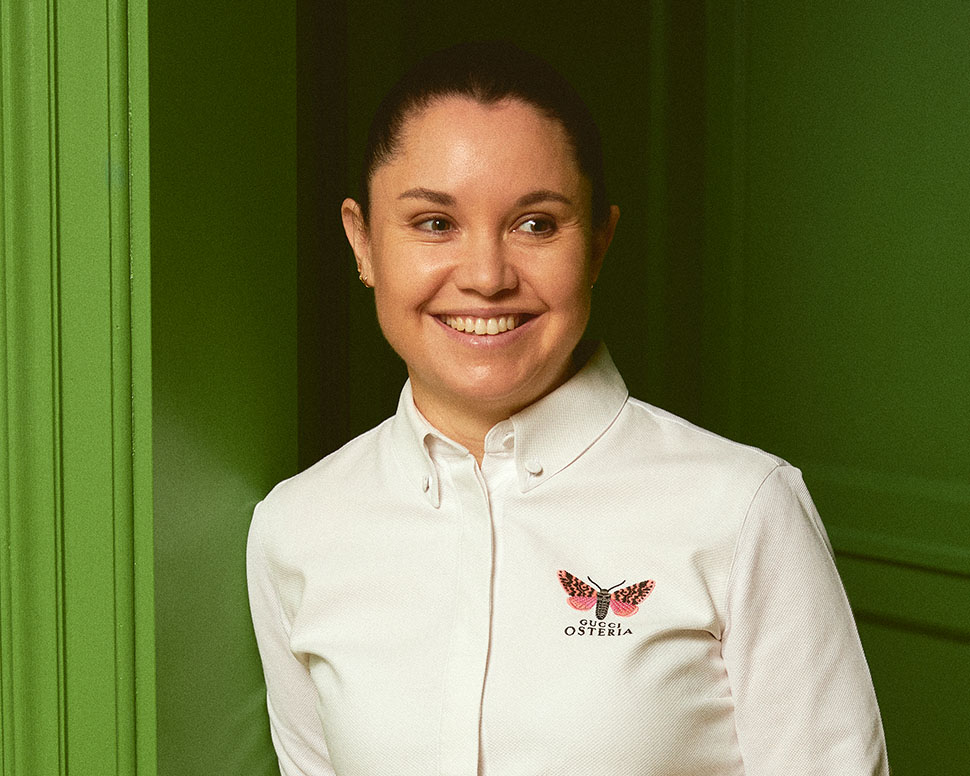
After four years of marital commuting between Florence and Modena, and with the arrival of their daughter Hana, the two chef spouses finally reunited. While this facilitated family life, it's the creative harmony, the shared alchemy of design, and the shared attitude to create wonders and fascinations that captivates those who sit at the tables of this magical place.

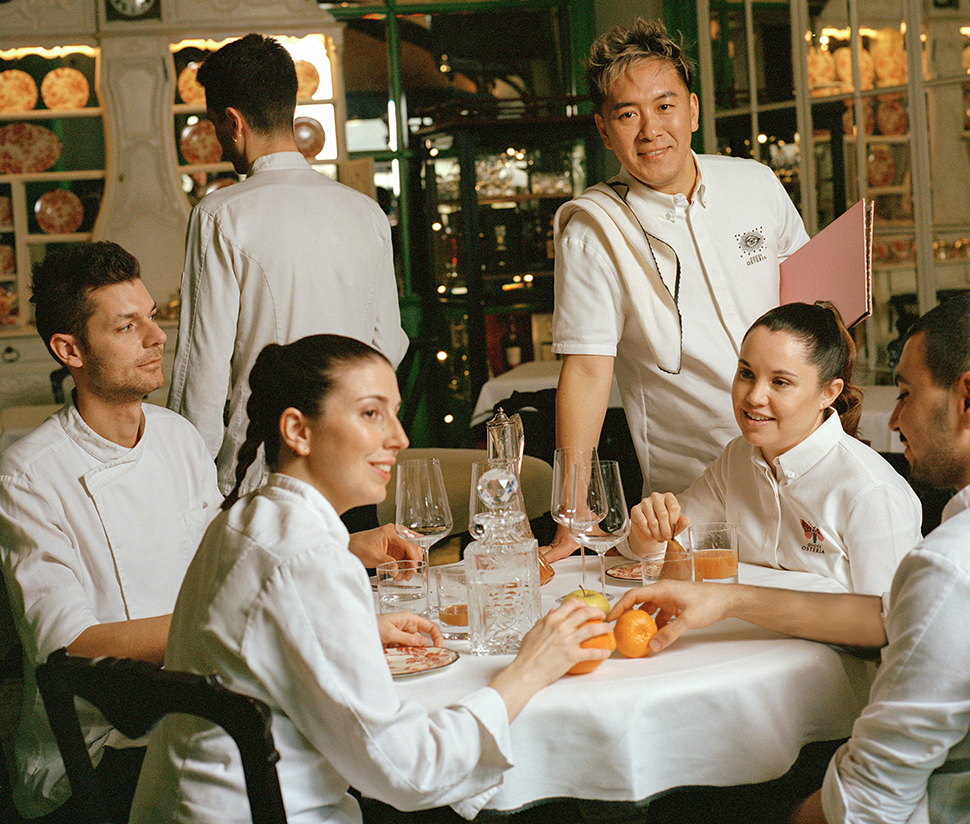
Yes, because the ambiance at Gucci Osteria is reminiscent of a fairytale. Upon entering, you're immersed in dreamlike design, an aesthetic that transitions into baroque shadows. Not only through interior style but also in the stylistic choices of informal yet refined service; delicate porcelain that blurs the line between design and art; dishes and their tales conveyed through playful codes and wordplay.


The entirety is buoyed by a pervasive multiculturalism, from which flows a strong and profoundly distinct energy, encompassing a sensory domain much wider than mere taste. "I cultivated creative thinking based on my experience at Pujol in Mexico City," Chef Karime says, "while at Central in Lima, I learned the importance of constant ingredient research. However, it's thanks to Massimo Bottura that I realized cooking is culture and that the solidity and cohesion of the team are everything."
Gucci Garden

For a year and a half, alongside the Osteria, Gucci Giardino 25 flourishes—an enchanting outdoor space in Florence. It's a café and cocktail bar led by Martina Bonci, an expert mixologist with a flair for the elegant at the counter. In just a few months, many of her drinks have become signatures. Take the purplish Mémoire di Negroni: a fusion of gin, white bitter, amber Martini, sake, yuzu, grapefruit bitter, and butterfly pea flower.

Marrying the essence of the maison's DNA with sippable delights, Martina often introduces the Gucci Osteria experience, beginning in Piazza della Signoria's outdoor space with her welcoming cocktails.
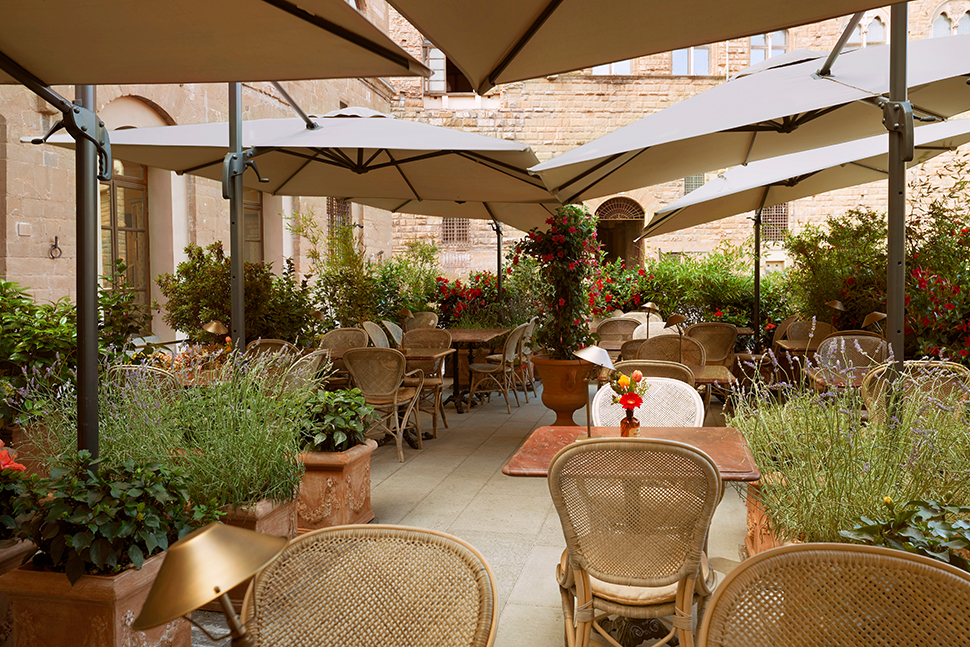
Similar to the Diamond, which takes inspiration from the first graphic motif, a Gucci symbol found in luggage design. It's balsamic at its core, with Aquavit, vetiver, spices, elderflower, and turmeric. Turmeric even lines the glass rim, though it's avoided with the first sip, allowing you to ease into the cocktail before experiencing its evolution.

Chartreuse wasn't Martina's favorite spirit, but she delved deeper into it. Adding gin, kiwi, chamomile, lemon, and basil-infused cedrata to both green and yellow chartreuse, she created the Elixir of Long Life. The name harks back to a 1605 monastic recipe found in an Abbey of Vauvert manuscript.
The Appetizers accompanying the aperitif embody rustic concepts elevated to refinement—like tomato bread and puffed Parmesan crusts. After the first taste, you'll be hooked.
The dishes
Lunch commences with a crispy cone filled with tzatziki sauce, trout roe, and crunchy potato crust; Chianti-classico-marinated osmotized pear, its reduction, lime, lemon, and orange zest; a choux pastry stuffed with tomato soup glazed with Parmigiano Reggiano.

The smoked cinta Senese shoulder, produced exclusively for Gucci Osteria by Paolo Parisi, is a triumph. Accompanied by a Campanine apple mustard and homemade fennel vinegar, it's served with extreme balance.

Among the baked goods, Tuscan extra-virgin olive oil grissini and one of the finest olive oil focaccias, a rustic take on schiacciata, make appearances.
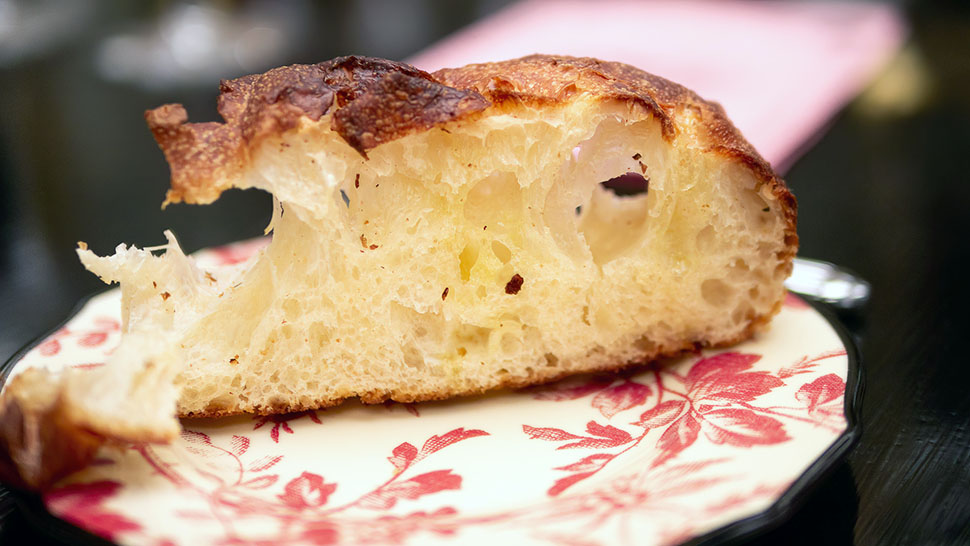
"Bendita Primavera" is a song title by a Mexican group, covering Loretta Goggi's song. Karime and Taka pay homage with a dish: seared scallops, crispy fava beans, raspberry fillets, and a leche de tigre reduction comprising scallops and raspberry. The mollusk's sweetness dances with acidic tones, punctuated by the fava's crunch.

In the glass, Ca’ del Bosco Riserva 2007, a private Gucci collection that acquired the entire 1800-bottle vintage. It's an 80% chardonnay, 20% pinot noir blend matured for six months on lees.
The Tostada de maiz viola is a dish that's anachronistically labeled historic, yet it's a cult favorite due to its clamor and acclaim. It perfectly embodies Karime's aesthetic. A crisp purple corn chip covers an Adriatic palamita, scented with lemon zest, scapece sauce, avocado mayonnaise, and chipotle, finished with a slightly spicy jalapeño touch, garnished with dehydrated avocado chips, radish, and hibiscus powder.
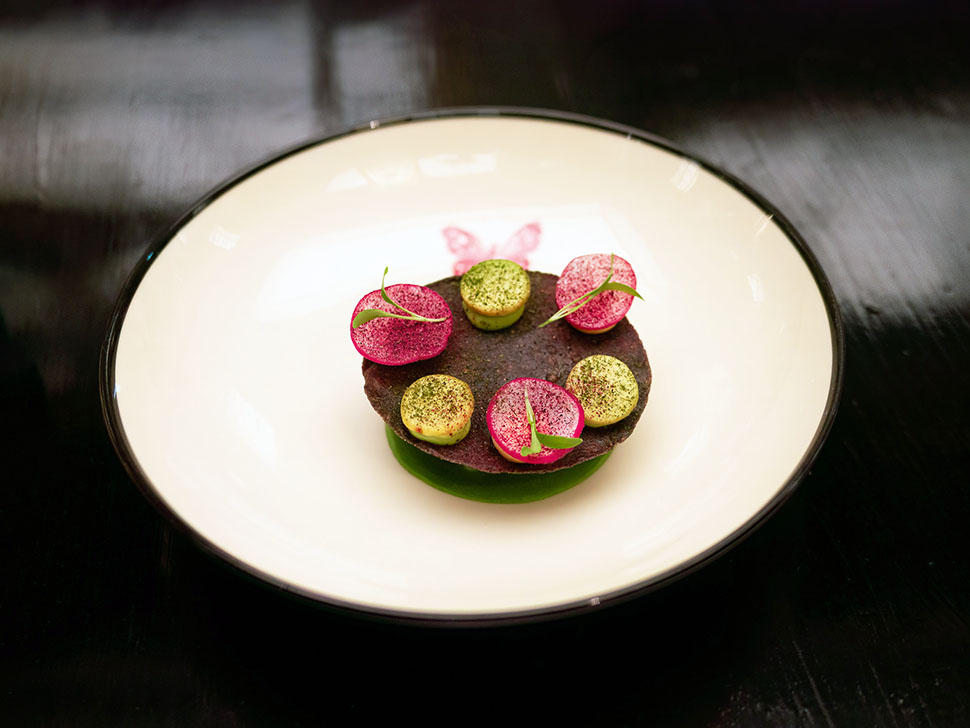
Torta in-Salata, a savory tarte tatin, houses boiled celery, carrots, and potatoes, mimicking a Russian salad—an "Italian salad" in Nordic countries, as Artusi explains. Complete delight infused with the tang of pickled red turnip and radish, and the freshness of shiso leaves and flowers, which also form the aromatic pink foam that binds it all together.

"When a Japanese person's semantic doubts in Italian are a blessing" could be the subtitle of Cannolo that wants to be a Cannellone.
Upon his arrival in Italy, Taka, struggling with Italian, confused similar-sounding words like cannellone, cannellino, and cannolo. To mark the moment he grasped their correct meanings, he created a dish incorporating all three elements—always with playful and ironic flair. A cannolo, resembling the traditional Sicilian pastry but with cannellini bean flour dough, filled with salted ricotta and Chianina beef ragù, complete with pistachio crumble on one end and candied orange zest on the other. A fusion that breaks down culinary dogma: first course, second course, dessert.

From Fattoria San Lorenzo, a combination of six different vintages (2014 - 2019) of biodynamic Campo delle Oche Verdicchio, accompanied the final two courses at varying temperatures, starting cooler and gradually warming.
A memory of a summer in Versilia is born from Taka and Massimo Bottura's trip to Viareggio's fish market, translated into a cod fillet served in a warm Mediterranean broth of sun-dried tomato and oregano, a n almost acqua pazza (crazy water). The dish's bitterness comes from crispy almonds, while a vegetable giardiniera of fennel and celery adds a fresh herbal note. The entire fish is used, with scraps contributing to the broth and the skin boiled and fried for a delightful airy texture that complements the cod's kudzu-connected flakiness.

The slightly fried Viaggio in Messico eggplant adorns itself with Mexican notes, with the sweet and bitter embrace of cocoa mole blending with a Chianina reduction and Brunello di Montalcino. Bold, direct flavors harmoniously contrast with ethereal edible gold-adorned butterfly pea chips.
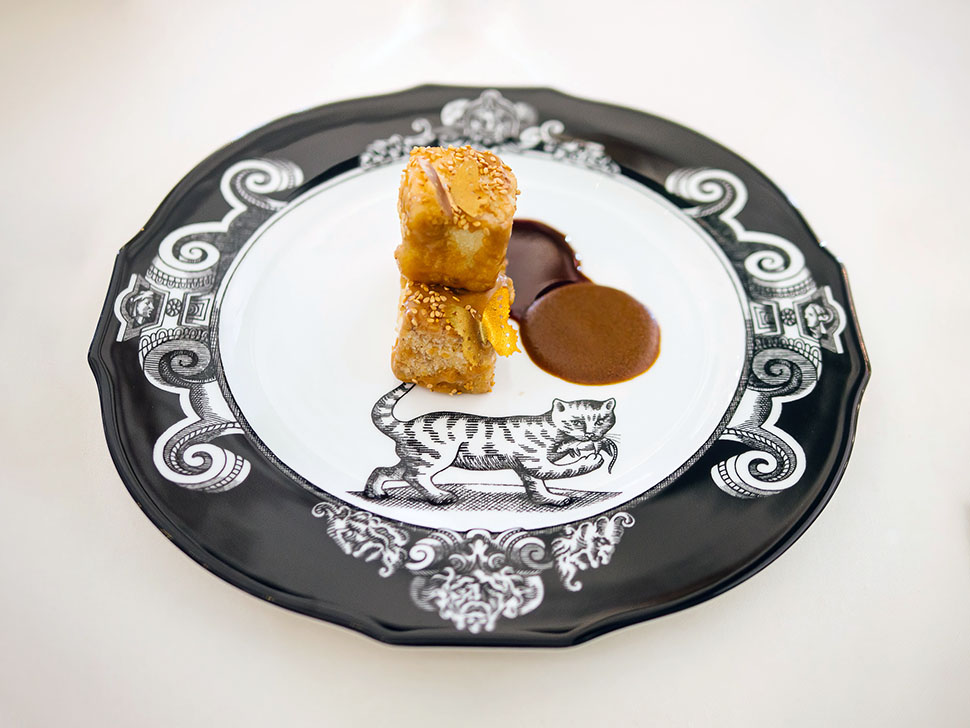
The spicy freshness and silky tannins of Fattoria Brena's 2018 Sopra, a pinot noir produced in just 2100 bottles, accompany the eggplant.
"Anguilla in carrozza" (Eel carrozza style) is glazed with pumpkin demi-glace to reduce its fatty component while amplifying its flavor with pumpkin's sweetness. Grated horseradish tops the ravioli filled with pumpkin and amaretto.

Remarkable is Taka's 'Non dire cassate,' as he, not being a dessert enthusiast, consistently strives to explore alternatives or reimagined versions of great classics, as in this case, the cassata. He has crafted his personal rendition, which is essentially a cold pasta, a practice widely spread in Japan. Thus, spaghetti with pistachio, Noto almond cream, adorned with a grilled Mazara shrimp.

The pairing continues with Sartie de La vela, a small Soleras method virgin marsala reserve, showcasing caramel, licorice, and cinnamon aromatics.
"Nomen Omen" perfectly captures the essence of the dessert "La gola," an impressively executed hazelnut salted gelato, adorned with cocoa nibs and tonka bean chips bearing the Gucci monogram.

We reach the "Compromesso storico," tortellini cooked in capon broth, served in a 24-month Parmigiano Reggiano cream. It's named so in an attempt to calm the debate on the best tortellini style—broth, dry, or cream-based—that each Emilian-Romagnolo town claims as a dictum. Karime and Taka decide to present it at the end of the meal, pleasing all with the slogan, "It's always tortellini time."

The petite pastry selection includes grapefruit extract and rosehip infusion; Vin Santo-infused madeleines with red fruit compote; blonde miso chocolate bonbons dusted with a slightly bitter cocoa powder; and Piedmontese gianduja chocolate bonbons with a lightly crunchy praline and salted pistachio
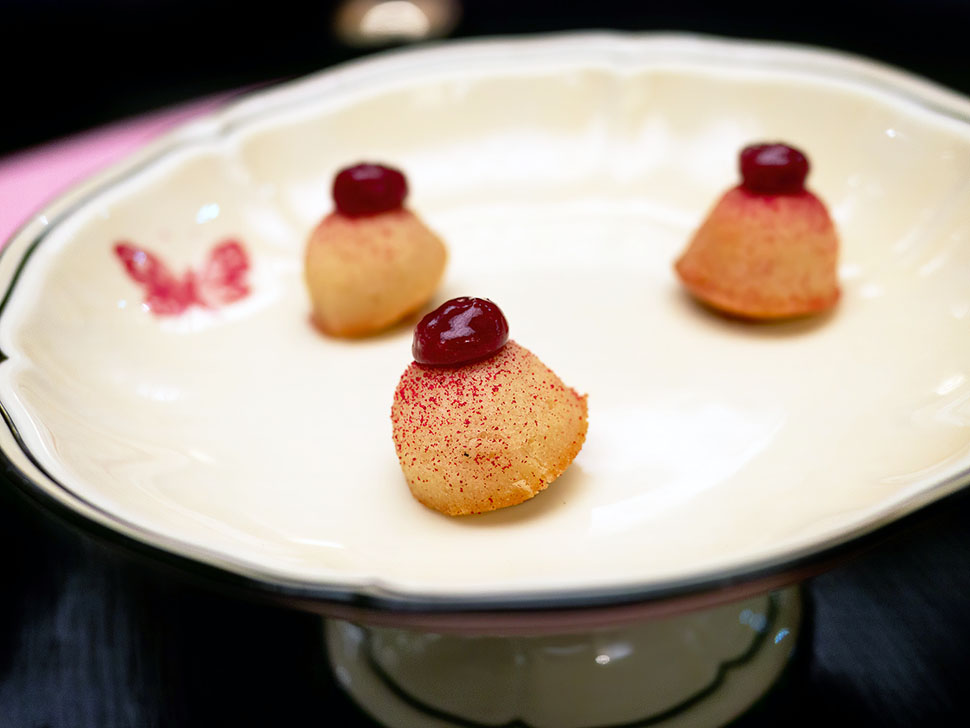
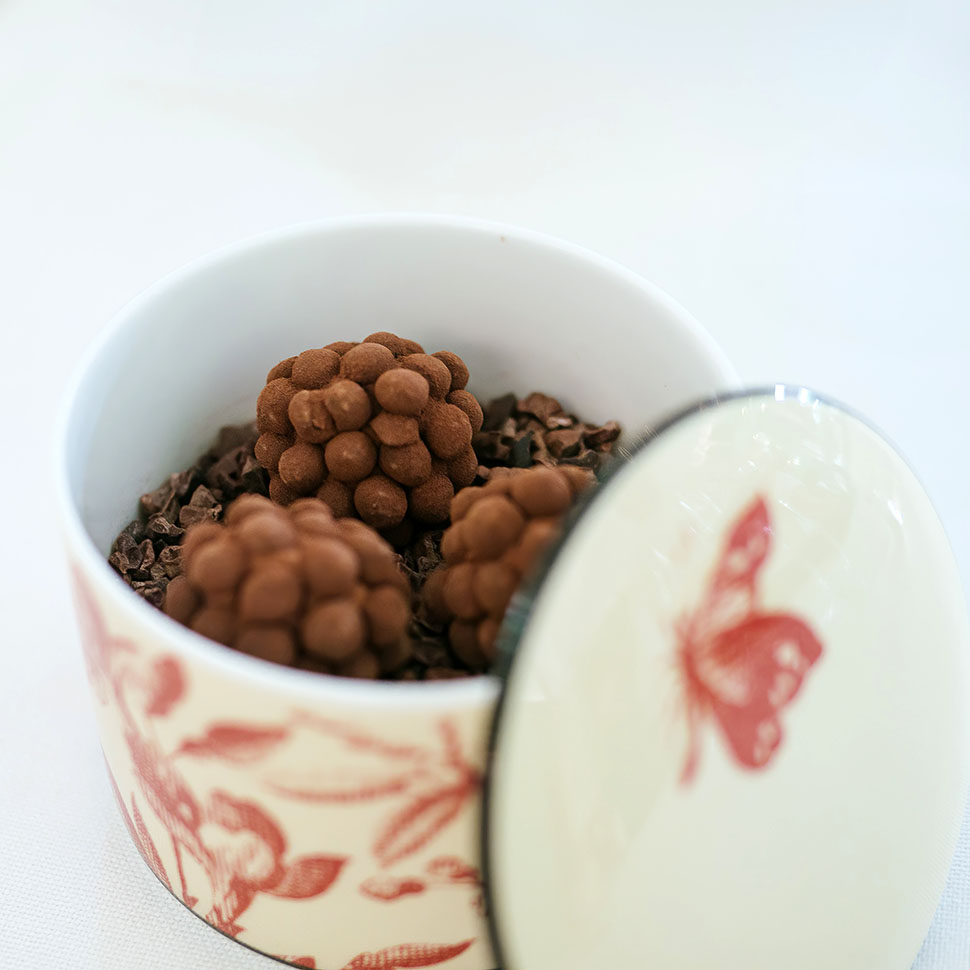
Gucci Osteria da Massimo Bottura
Piazza della Signoria, 10 - 50122 Firenze
Tel. +39 055 062 1744











